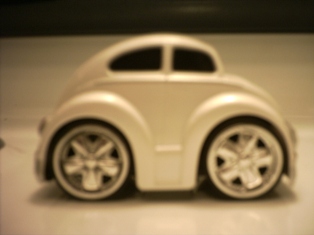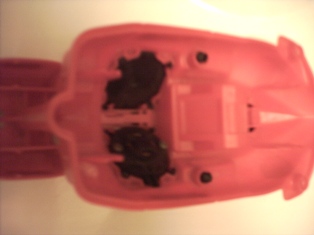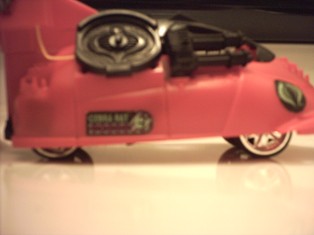I started out on this project with the idea that it would be fun to take the parts for a remote controlled car and put them into an old G.I. Joe vehicle. As I researched building RC cars I realized it was an expensive and intricate process to build one from scratch. With very limited skill in electronics or with motors but planning on gaining more, I decided to start with something that I knew worked before I got a hold of it.
|

|
After acquiring a car, I had to decide which vehicle to integrate it into. I chose the Cobra RAT because it had plenty of space (so I thought) under it to house the parts. This particular one was already missing the wheels, so it was that much more of an improvement to the vehicle.
|
 |
 |
After this, I removed the cover from the RC car, exposing it's insides. I tried to fit the car insides into the RAT but there wasn't enough space for the whole assembly in one area. The only option was to separate the various components (Battery pack/controller board, rear drive assembly, front steering assembly) and mount them in separate areas of the vehicle. This would require the lengthening of wires between the motors and battery pack.
|
 |
During the disassembly process, many of the wires either separated from their elements from being moved around or had to be cut to lengthen them. I soldered the elements that needed reconnected (three solders between the two motors, one on the battery pack and another to reattach the antenna) and tested the parts. NOTHING! After checking the connections and making sure the motors and gears were all situated correctly, I tested it again. I had to repeat this for a while until I figured out there were loose connections between the motors and battery packs. Finally, everything was fixed and the motors ran dandy.
|
|
Now that everything was working, the time finally arrived to mount everything inside the RAT. the casings from the car parts and the RAT didn't match up well enough for epoxy to connect as well as I wanted, so I used electrical tape to build slings to hold everything in. This also left me the option of adjusting how things sat inside. It proved useful because many times while I was getting the alignment right, the wheels would drag against the plastic and stutter, losing forward motion.
|
 |
 |
| All fixed up, ready for a test run! The increased weight due to the heavier shell seems to make for a higher drain on the batteries. It's also somewhat tempermental, making just operating it a feat in itself. That's part of the fun with it to me, though, making on the fly repairs is almost more interesting to me than building it in the first place. |
|











